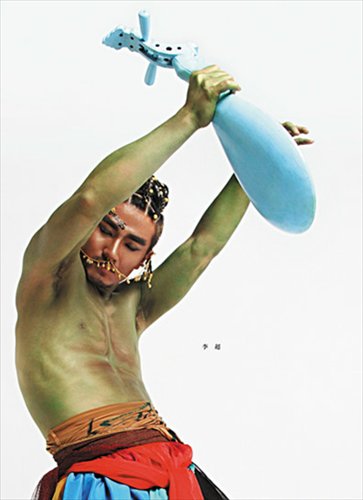Dance drama compares the Tang and Song dynasties
As part of the 15th China Shanghai International Arts Festival, Beijing-based choreographer Zhao Xiaogang's latest dance work, Fat Tang & Thin Song, will be staged at the Shanghai Oriental Arts Center on October 19 and 20. It would be incorrect to assume that the performers themselves demonstrate the contrasting physical characteristics of the title.

A dancer presents an image of Buddha in the Dunhuang Caves. Photo: Courtesy of Zhao Xiaogang
"'Fat' & 'Thin,' are metaphorical," Zhao told the Global Times. "'Fat' here refers to the Tang Dynasty's (618-907) all-embracing, tremendously tolerant culture and 'thin' refers to the more delicate culture of the Song Dynasty (960-1279). None of us were there during the Tang and Song, so no one knows what people and things at that time really looked like. So any art needs artistic license, especially dance."
Therefore, in Fat Tang & Thin Song, everything starts with modern people's imagination. While visiting the Dunhuang Caves in Gansu Province, sites of Buddhist worship that flourished during the Tang, a present-day Chinese man dreams about the ancient dynasty.
Zhao explained, "Most visitors to the Dunhuang Caves don't pay much attention to the statues or the frescos at the bottom of the cave - these are the portraits of the patrons of the cave and their family members." In Zhao's opinion, the reason those ordinary people's portraits were put together with the images of various Buddhas, which are usually at the top of a temple, is because ancient Chinese people believed and pursued a kind of harmonious and peaceful coexistence between god and human beings, between Buddha and ordinary people. In Zhao's production, the performers who play the providers and the performers who play the Buddhas dance together, breathing life into the statues and frescos.
Zhao included many of the most famous figures and stories from the Tang Dynasty, considered a golden age of Chinese civilization, including China's only female emperor, Wu Zetian, and the romance between Emperor Tang Xuanzong and one of his concubines, Yang Guifei. Also featured are Li Bai and Du Fu, the two greatest Tang poets, who had completely different styles; Li was a romantic while Du practiced realism. "For the Tang Dynasty part, the whole stage, from the lighting to the costumes, is full of bright colors. And even the music for this part - I intentionally chose a foreign symphony," Zhao said.
However, once the drama enters the Song Dynasty, everything on stage becomes more subdued. The costumes are plain and elegant with simple colors and traditional Chinese music is used as the score. The characters of the celebrated Song writers Li Qingzhao and Su Shi appear.
Date: October 19 and 20, 7:15 pm
Venue: Shanghai Oriental Art Center 上海东方艺术中心
Address: 425 Dingxiang Road
丁香路425号
Tickets: 80 to 880 yuan
Call 6854-1234 for details